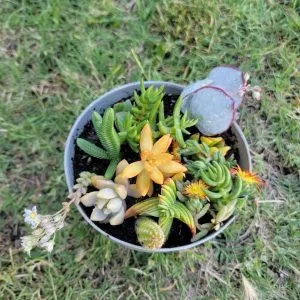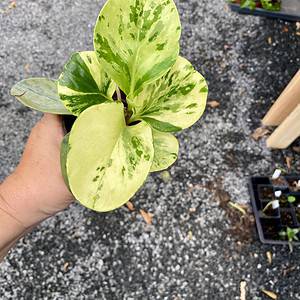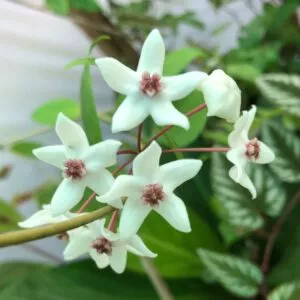No products in the cart.
Do you have feline friends at home? If you do, then why not grow a tasty treat for them? Not sure what it is all about!
Well, then, you must stay longer to learn how you can grow cat grass seeds indoors for your cats.
What is Cat Grass?
Yes, cat grass is for your cats to provide them with a healthy nibble. Eating grass for our feline companions is a natural thing. Like catnip and catmint, the grass is safe for pets and harmless.
The worst thing that can happen is that your cat throws it up after eating. The other fantastic thing is that it will keep your pets away from other plants. Another important note is that cat grass is not a specific grass but a mix of different grass to grow indoors.
These cat grass seeds can be made up of oats, rye, barley, and wheatgrass and are not the same as the lawn you have outdoors. So, you grow it for your indoor cats. The best part is you can find a cat grass kit at your local pet store or here with us at Plantly.
With us, you purchase different seeds to plant, like wheat and barley grass, too much more. A favored grass is a wheat berry, and your cats can chew it directly from the pot. Here are some other popular varieties you can grow:
Wheat Grass: as humans, cats appreciate some wheatgrass occasionally. It is a prevalent cat grass seed variety to start with. The best part is you can grow it for yourself as it has loads of health benefits.
Oat Grass: cat grass is high in fiber and on the sweet side when you taste it and is preferred by people compared to wheatgrass.
Barley Grass: yes, this grass is sometimes forgotten and is a cereal grain filled with minerals to blend with other cat grass seeds.
Ryegrass: people seem to forget about this grass as it is a livestock feed that cats love.
Flax: you do not find flax in all blends of cat grass seeds, but you need to use it in small quantities and pull it out when it reaches more than five inches.
Orchardgrass: A high-quality grass, that offers numerous benefits. It provides high-quality forage for livestock, with excellent digestibility and palatability. Consider harvesting orchard grass in spring for you to get the maximum nutrients from the plant.
Is Cat Grass Important?

cat eating catgrass @jiva
Cat grass is an essential perennial herb. Most outdoor cats do not need it much, but outdoor felines can still enjoy the grass. Why cats eat grass still confuses a lot of scientists. But many have determined it can be for gastrointestinal purposes.
As cats get furballs when grooming, it helps them to eject them when eating grass. Still, it is not the only theory about why cats eat grass. Cat grass is high in fiber and contains folic acid helping a cat’s stomach settle.
Another theory is that cat grass helps provide some nutrients. But, no matter the reason, there is one thing that everyone agrees on: it is normal and an instinct that outdoor cats do. Another notable thing is it freshens up your cat’s breath.
That brings us to another important question. How much cat grass should your feline eat? Well, it depends on how your cat responds when you grow cat grass, and the best is to do some testing.
If your cat ignores a specific cat grass, it might not need it now. Keep observing your pet’s natural behavior to know what type of cat grass seeds to grow. We suggest limiting the intake to small portions first, and if there is no problem, let them have more.
So, keep an eye on your cat and have it available when shedding starts, or you see your cat wanting to chew on the lawn outdoors. Provide your cats with up to three grass sessions a week.
When you notice your cats want it more than often, we recommend visiting the vet.
How To Grow Cat Grass From Seed

You can create your very own organic garden when you grow cat grass seeds from oat grass, wheat grass, or other grasses. There are many ways to provide your indoor cat with the grass nutrition they need.
The best part is your kitty will not get weed killers found on the lawn outside. You can choose cat grass kits, grow single-type seeds like wheat grass seeds, or mix them with other cat grasses. You can plant cat grass in a soil blend, soilless mix, or even in water.
No matter the method you choose for growing cat grass, it helps to pre-soak the seeds for half an hour in lukewarm water. Doing this helps the seed rehydrate to germinate and grow.
Starting Cat Grass Seeds Like Oat Grass in Soil
First, select your potting soil, like fresh potting soil, to use with your seed starting blend. You can use a standard potting mix if you prefer. But choose organically fertilized soil, allowing plenty of food for your cat’s grass seed to grow.
Then select a container that you can fill up to a quarter inch below where you would like it to grow. Spread your rye seeds or wheatgrass seeds evenly across the soil. You can seed heavily, but if you want, you can go sparingly.
With heavy seeding, it can grow enough for healthy nibbling. Then add a thin layer of soil barely covering the seeds and water well. Keep the grass seeds at a warm temperature, so the seeds germinate.
Provide enough light for indoor growing and keep the soil moist. A place like a sunny windowsill is ideal.
Using a Soilless Mix

When you want fresh growth, planting cat grass can provide a natural way for your feline friends to chew grass. So, you can grow the cat grass seeds in another method in a soil-free media like coconut coir.
Hence, if you choose this route, we recommend mixing one part horticultural perlite, two parts coconut coir, and half part vermicast. Doing this provides most indoor plants with food, moisture retention, and drainage.
Another nice thing about this method is that it is not messy, leaving you many cleanups. Occasionally you may see your cat pulling out a blade by the roots when chewing, leaving a lot of dirt with potting soil.
Also, starting the cat grass seed is the same as the previous method. You can fill the container about a 1/4 inch below where you plan to add the seed. Doing this allows enough space when the seedlings to emerge.
For a lot of grass, sow heavily, and for little grass, sow a fine layer of the seeds. Also, remember to pre-soak your wheat with rye and other pet grass seeds. Then add the seeds and water them well.
It also helps to pre-moisten the potting medium using coir with warm water to speed up moisture absorption. But let it cool down before the cat grass seeds are planted. Another great thing is to cover the container with plastic wrap to form a greenhouse effect.
But keep removing it daily for air circulation, and use a spray bottle to spritz some water to keep the soil evenly moist. Then, place the seeds planted in natural light until you see seedlings emerge.
Then remove the plastic wrap and care for it as normal.
-
Free Shipping$20.00Sold By: Blessed Family Farm
In stock
ASSORTED SUCCULENT ARRANGEMENT
Rated 4.82 out of 5 based on 22 customer ratings01Sold By: Blessed Family Farm -
$18.00Sold By: Smoot's Farm
In stock
Peperomia Marble 4 Inch Pot Live Plant
Rated 4.89 out of 5 based on 27 customer ratings00Sold By: Smoot's Farm -
$9.99Sold By: Cacti and Exotica
In stock
4″ Kalanchoe synsepala
Only 10 available and it’s in 1 people’s basketRated 4.98 out of 5 based on 59 customer ratings00Sold By: Cacti and Exotica -
$17.95Sold By: SunSoul Plants
$29.95In stock
Hoya Iris Marie plant potted in 4″ pot
Rated 4.87 out of 5 based on 98 customer ratings00Sold By: SunSoul Plants
Growing Cat Grass in Water
You do not need soil to grow grass for your domestic cats indoors. You can use hydroponic growing media, but you only need a little bit. Ensure that the container you use has no drainage holes.
Take the container and fill the lower part with the hydroponic media like expanded clay pellets or use grow stones. You can use perlite, but you need to keep monitoring it to not float to the top.
When using perlite, ensure the water level is the same as the perlite.
Next, place a coffee filter over the top of the media to act as a wick for the grassroots and the soil.
Spread your pre-soaked mixed seeds on top of that coffee filter. You can also use a paper towel.
Once seedlings start emerging, the roots penetrate the filter into the media.
We do not recommend placing the container in full sun but in a sunny location with bright indirect light. Add clean water as needed.
What Are The Best Containers For Growing Cat Grass?

A bonsai pot is one of the best containers for growing grass indoors. You can cover them with landscape fabric over the drainage holes. Still, if you cannot afford one, choose a pot allowing your cat full access to chew on the grass.
The container must be heavy enough to prevent your cats from tipping them over. Whether you use a soil or soil-based mix, both need good drainage. Some excellent options are shallow containers made from glazed ceramic or terracotta.
Another thing is you can find matching saucers to catch the excess water to remove and prevent root rot.
For water growing, use anything that can hold water without running out. But use something heavy to prevent water spills or getting knocked over. Ensure that the container is not too tall for your cats to reach. While the plants grow taller, a deep container will not work.
Growing and Caring For Your Cat Grass
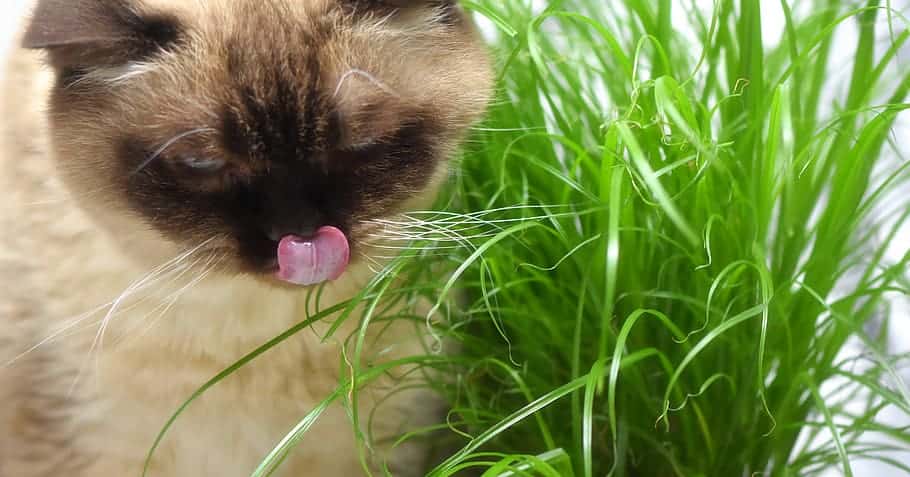
Once you start to sow the cat grass seed, you need to keep that stuff going in your organic garden to have your own cat grass. So, how do you take care of your cat grass for indoor cats? We are here to help!
The Recommended Light and Temperature
As the grass grows outside your indoor cat, grass also needs light. The truth is you need less than what you think for your crop. When growing cat grass in a dark period, you can use grow lights or find a spot with some direct light.
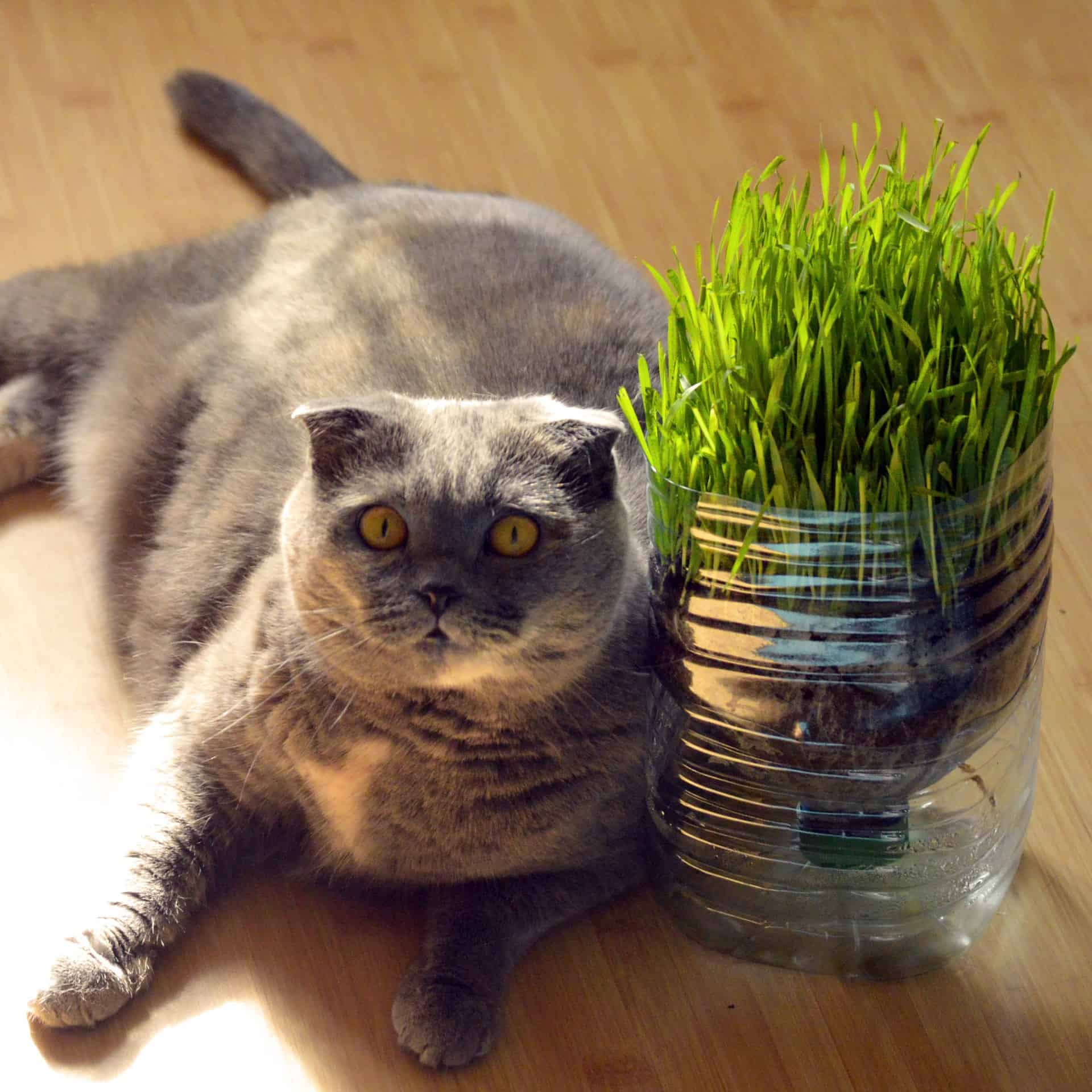
When the grass blade is a lovely bright green color, you know it is healthy. But when they turn yellow, you need to find more direct sunlight. Outdoor grass grows in full sun to partial shade. But full shade is not recommended, so try finding a sunny spot.
Your grass can grow on the patio to take the heat, but ensure it receives regular watering. But colder temperatures can become a problem, especially when reaching freezing temperatures. The best is to bring your containers indoors.
A great place for winter growing cat grass is a garage with fluorescent plant lights or a heat mat. This keeps the soil warm even if the temperatures dip down to the 20s or 30s. So remember, do not place your cat grass in a dark place.
Water and Humidity
When grass seedlings start emerging, it helps to keep the soil moist to sprout. It can take up to four days for them to start appearing. Using soil or soilless medium needs to remain moist but not soggy.
Water growing only provides enough water to keep the wick used moist. Expanded clay pellets will draw moisture from the filter’s seed base. The other problem is providing the correct humidity for them to grow.
When the air is humid and hot, your cat grass starts to droop, which is the only problem you will have. You can place the pot on a pebble tray for a container growing with water.
Refreshing Your Memory
We have described the different types of soil you can use, but we want to refresh your memory.
For a soil-based mix, you can use any potting mix used in the garden or for house plants. The crucial thing is to use a medium that retains moisture and must not be as hard as a rock.
For a soilless medium, as mentioned, used 2pt coconut coir, 1/2pt worm castings, and 1pt horticultural perlite. You can even grow cat grass in tree bark.
Add some expanded clay pellets or stone as a filler for water as your growing media.
Fertilizing Cat Grass
Regarding feeding cat grass, it comes to your personal preference. Cat grass plants require more direct sun and water than fertilizer. If you use a feed, choose one that is all-nitrogen, or skip it. Alternatively, use worm castings to boost grass growth after the seeds sprout.
Trimming Your Cat Grass
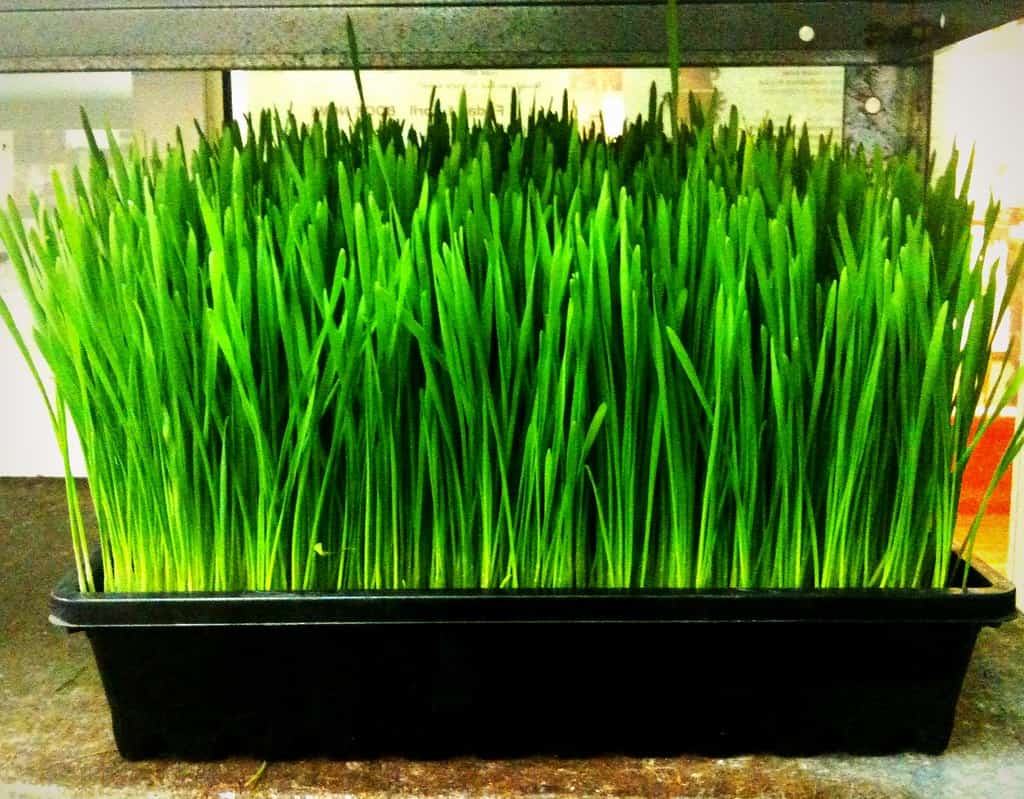 wheatgrass @theenmoy
wheatgrass @theenmoy
Cat grass grown indoors can become wild like the grass growing outside. The truth is your cats are the best indoor lawnmowers. Still, if the grown cat grass becomes scraggly, you must trim them.
You can trim them about three inches above the soil level to keep your cat grass healthy. The blades will stand up straight, but you may find the majority of trimmings done by your feline friends.
You can take the trimmings to toss into a compost tumbler or a worm bin.
How Long Will The Cat
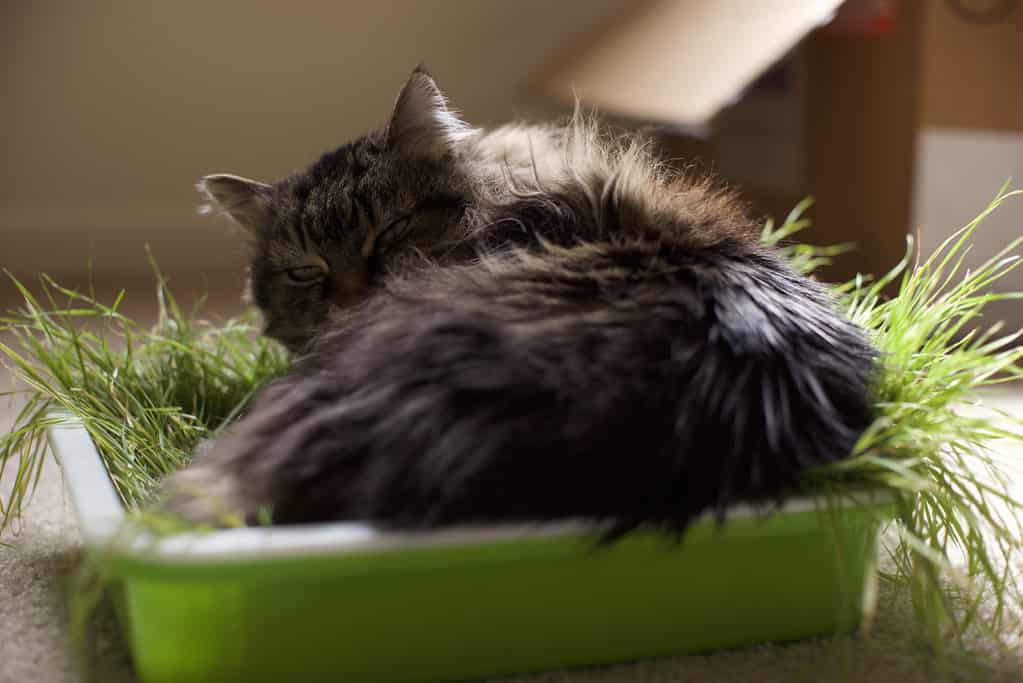 black cat lying on top of catgrass bed @wabisabi2015
black cat lying on top of catgrass bed @wabisabi2015
Estimating how long the cat grass will last is difficult. There are a few variables to consider, and one is the consumption level. The other is how thick or thin the grass grows. The other is your growing medium, which also makes a huge difference.
So, whether you choose to use cat grass kits or make your medium, both have its outcome. The critical thing to remember is that cat grass seed is common cereal grain like oats, rye, and wheat.
When grown in the garden, it can grow much larger, but in tight spaces, it does not have that much room to grow. Hence, they start competing with one another, slowing down the growing process with time.
For this reason, we recommend starting a new batch every two to three weeks. You will find that most domestic cats prefer chewing on grass blades that are about four inches long.
How to Dispose of The Old Cat Grass?
Once the cat grass starts looking tired, you can compost it and start again. You can cut the grass off to soil level and start a new batch for growing in a soil or soilless medium. The roots will decompose to provide more nutrition.
For water cat grass growing, remove the filter, which will remove the roots, and toss it on the compost pile.
The Pros and Cons of Each Growing Media
 catgrass @johnbenson
catgrass @johnbenson
While you can grow cat grass in various potting mediums, each has pros and cons. Therefore it helps to mix your potting medium with the following to add more benefits. First, choosing soil is a natural growing medium providing minerals and nutrients the outdoor plants need.
The soil provides root stability and can continue growing while it naturally prevents mold and ensures root and leaf ventilation. Yet, using only coir and vermiculite alone has more negatives than positives, and best to use them together as described previously in the article.
Vermiculite alone does not provide root stability to the minerals and nutrients the seeds need to grow. In contrast, coir alone can promote mold and has water retention that can result in root rot. It can, when used alone, result in poor ventilation and does not provide nutrients and minerals used alone.
So, consider these things before deciding to use only coir or vermiculite.
Wrapping Things Up About Cat Grass
If you have thought: Is cat grass safe, then yes. But where can you buy these healthy grasses? You can find small packets of seeds at a nursery, but it is only a few grams and does not last long. These are known as cat grass kits.
Alternatively, you find it available at a local pet store or online at other places. Nonetheless, the good news is you can buy single types of pet grass seeds or proprietary mixes at Plantly. While using a pet grass kit is fantastic, you often do not know the soil quality.
Hence, you can choose your seeds from wheat grass and oats grass to other blends to grow mixed as a treat for your feline friends. At the same time, you can pick your favorite bonsai container with a saucer and invest in two to start with one batch and then another fresh batch.
For water-growing cat grass, you can use any watertight container and buy the media from us.
If you want to maximize and use all cat-friendly houseplants indoors, check this article, 7 Plants That Are Safe to Have Around Your Cats for more options.
Whether you want to buy, sell, or simply reach out to other plant enthusiasts, Plantly is the right place to be!
-
$16.00Sold By: Beauties & Beasts
In stock
Cactus – Echinopsis chamaecereus (clumping)
Rated 4.83 out of 5 based on 24 customer ratings00Sold By: Beauties & Beasts -
$14.99Sold By: BubbleBlooms
In stock
Green Velvet, Alocasia Frydek, Micholitziana, 4 inch, live rooted potted rare succulent house plant
Only 99 available and it’s in 1 people’s basketRated 4.81 out of 5 based on 279 customer ratings01Sold By: BubbleBlooms -
Free Shipping$39.95Sold By: CKK PRODUCTS LLC
$49.95In stock
FUYU Persimmon seedlings – large size
Rated 5.00 out of 5 based on 1 customer rating00Sold By: CKK PRODUCTS LLC -
$14.99Sold By: BubbleBlooms
In stock
Blue Columnar Cactus, Pilosocereus pachycladus Cacti, Column cactus, tall blue torch cactus, in 2 inch square pot
Rated 4.81 out of 5 based on 279 customer ratings00Sold By: BubbleBlooms
